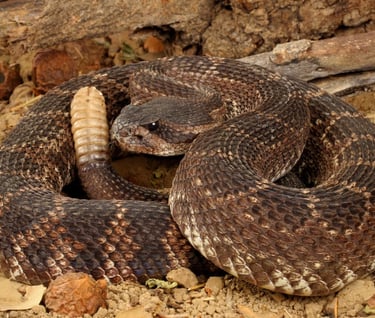Rattlesnakes + Dogs =Trouble


This post may have affiliate links. As an Amazon Associate, we earn from qualifying purchases from those links. This does not cost you anything and helps support the Sanctuary and all the animals in our care. This has no bearing on our reviews and comparisons. We will do our best to keep things fair and balanced to assist you in making the best decision for you and your animals.
Rattlesnakes are a group of venomous snakes that are commonly found in the western United States. They are characterized by the rattle at the end of their tails, which they use as a warning signal when they feel threatened. Rattlesnakes are typically solitary and nocturnal animals that prefer to live in dry, rocky areas, such as deserts and prairies. Mating season for rattlesnakes usually occurs in the spring, when males will compete with each other for the attention of females. After mating, female rattlesnakes will give birth to live young in late summer or early fall. Rattlesnakes feed on a variety of small animals, including rodents, lizards, and birds. They have heat-sensing pits on their faces, which allows them to detect prey even in complete darkness.
Common Ways Dogs Get Bitten by Rattlesnakes:
Dogs are often bitten by rattlesnakes while hiking or exploring in areas where rattlesnakes are known to live. Dogs may also be bitten while playing with or trying to catch a rattlesnake. In some cases, dogs may even accidentally step on a hidden rattlesnake while walking through tall grass or brush.
Common Misconceptions about Rattlesnake Bites:
Don’t attempt to “make an X” and cut open the area around the bite; you will only cause a wound.
Don’t bother to use a Snake Bite Kit or Extractor Pump — they’ll actually do more harm to your dog.
Don’t rub any substances into the snake bite. At this point, the venom has entered the bloodstream, and any substance applied topically is ineffectual.
Don’t apply a tourniquet; you will only succeed in causing further tissue damage and possibly create a need for limb amputation.
Don’t allow your pet to move about freely. IF they are bit on a leg, immobilize it.
DO NOT attempt to capture the snake for later identification - and DO NOT bring it to the veterinary hospital with the dog. If you are worried about the type of snake and ONLY if you can do it safely, take a picture - but to not attempt to capture it.
Venom Interactions with a Dog's Anatomy and Physiology:
Rattlesnake venom contains a mixture of toxins that can cause a variety of symptoms in dogs. The venom can cause local swelling and pain, as well as more serious symptoms such as vomiting, diarrhea, weakness, and difficulty breathing. In severe cases, rattlesnake venom can cause a dog's blood pressure to drop rapidly, leading to shock and even death.
Common Rattlesnake Treatments for Dogs in Veterinary Hospitals:
If a dog is bitten by a rattlesnake, it is important to seek veterinary care immediately. Treatment may include administering antivenom to neutralize the venom, as well as providing supportive care to help manage symptoms. In some cases, dogs may need to be hospitalized for several days to receive treatment and recover. The mortality rate for rattlesnake bites in dogs can vary depending on the severity of the bite and how quickly treatment is received, but it can be as high as 30% in untreated cases.
Prevention and Rattlesnake Vaccines:
Preventing rattlesnake bites in dogs is the best way to avoid the potential risks associated with these venomous snakes. Keeping dogs on a leash while hiking or exploring in areas where rattlesnakes are known to live can help reduce the risk of a bite. Some owners may also choose to have their dogs vaccinated against rattlesnake venom. The rattlesnake vaccine is a series of injections that can help reduce the severity of a rattlesnake bite in dogs. It is important to note that the vaccine does not provide complete protection against all types of rattlesnake venom, and dogs may still require treatment if bitten. Additionally, it is important to have a well-stocked first aid kit on hand when hiking or exploring with a dog, which should include items such as a Sam splint to immobilize the limb. Be sure to get your veterinarian to review your first aid kit so you can get recommendations and medications needed to keep your pet safe.
Rattlesnakes + Dogs = Trouble
From April to October snakes are active. Here are some tips to keep your dog safe.
